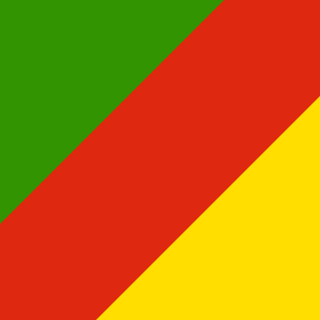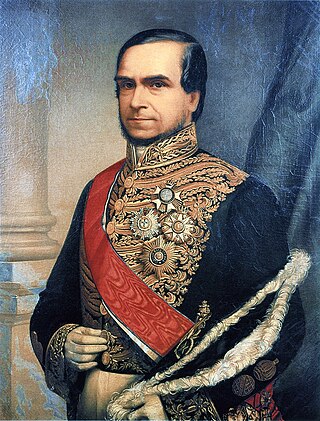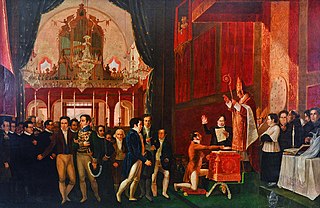Contents
| 1840 in Brazil |
|---|
| Flag |
 19 stars (1823–70) |
| Timeline of Brazilian history |
| Empire of Brazil |
| Year of Constitution: 1824 |
Events in the year 1840 in Brazil .
| 1840 in Brazil |
|---|
| Flag |
 19 stars (1823–70) |
| Timeline of Brazilian history |
| Empire of Brazil |
| Year of Constitution: 1824 |
Events in the year 1840 in Brazil .

A quilombo ; from the Kimbundu word kilombo, lit. 'war camp') is a Brazilian hinterland settlement founded by people of African origin, and others sometimes called Carabali. Most of the inhabitants of quilombos, called quilombolas, were maroons, a term for escaped slaves.

The Ragamuffin War or Ragamuffin Revolution was a Republican uprising that began in southern Brazil, in the province of Rio Grande do Sul in 1835. The rebels were led by generals Bento Gonçalves da Silva and Antônio de Sousa Neto with the support of the Italian fighter Giuseppe Garibaldi. The war ended with an agreement between the two sides known as Green Poncho Treaty in 1845.

The Riograndense Republic, often called the Piratini Republic, was a de facto state that seceded from the Empire of Brazil and roughly coincided with the present state of Rio Grande do Sul. It was proclaimed on 11 September 1836 by general Antônio de Sousa Neto as a direct consequence of the victory obtained by gaúcho oligarchic forces at the Battle of Seival (1836) during the Ragamuffin War (1835–1845). It had a constitution adopted in 1843 and was recognised only by the United Kingdom, France, and Uruguay.

Luís Alves de Lima e Silva, Duke of Caxias, nicknamed "the Peacemaker" and "the Iron Duke", was an army officer, politician and monarchist of the Empire of Brazil. Like his father and uncles, Caxias pursued a military career. In 1823 he fought as a young officer in the Brazilian War for Independence against Portugal, then spent three years in Brazil's southernmost province, Cisplatina, as the government unsuccessfully resisted that province's secession in the Cisplatine War. Though his own father and uncles renounced Emperor Dom Pedro I during the protests of 1831, Caxias remained loyal. Pedro I abdicated in favor of his young son Dom Pedro II, whom Caxias instructed in swordsmanship and horsemanship and eventually befriended.

The Brazilian Naval Revolts, or the Revoltas da Armada, were armed mutinies promoted mainly by admirals Custódio José de Melo and Saldanha da Gama and their fleet of rebel Brazilian navy ships against the claimed unconstitutional staying in power of president Floriano Peixoto.

Manuel José de Araújo Porto-Alegre, Baron of Santo Ângelo, was a Brazilian Romantic writer, painter, architect, diplomat and professor, considered to be one of the first Brazilian editorial cartoonists ever. He is the patron of the 32nd chair of the Brazilian Academy of Letters.
The Malê revolt was a Muslim slave rebellion that broke out during the regency period in the Empire of Brazil. On a Sunday during Ramadan in January 1835, in the city of Salvador da Bahia, a group of enslaved African Muslims and freedmen, inspired by Muslim teachers, rose up against the government. Muslims were called malê in Bahia at this time, from Yoruba imale that designated a Yoruba Muslim.

The Constitutionalist Revolution of 1932 is the name given to the uprising of the population of the Brazilian state of São Paulo against the Brazilian Revolution of 1930 when Getúlio Vargas assumed the nation's presidency; Vargas was supported by the people, the military and the political elites of Minas Gerais, Rio Grande do Sul and Paraíba. The movement grew out of local resentment from the fact that Vargas ruled by decree, unbound by a Constitution, in a provisional government. The 1930 Revolution also affected São Paulo by eroding the autonomy that states enjoyed during the term of the 1891 Constitution and preventing the inauguration of the governor of São Paulo, Júlio Prestes, who had been elected president of Brazil in 1930, while simultaneously overthrowing President Washington Luís, who was governor of São Paulo from 1920 to 1924. These events marked the end of the First Brazilian Republic.

John Pascoe Grenfell was a British officer of the Empire of Brazil. He spent most of his service in South America campaigns, initially under the leadership of Lord Cochrane and then Commodore Norton. He was the nephew of British politician Pascoe Grenfell and grandfather to General Sir John Grenfell Maxwell. In Brazil, he rose to the rank of admiral and for his achievements was made a knight grand cross of the Imperial Order of the Rose and a knight of the Imperial Order of the Southern Cross.

The Cabanagem was a popular revolution and pro-separatist movement that occurred in the then province of Grão-Pará, Empire of Brazil.

The Federalist Revolution was a civil war that took place in southern Brazil between 1893 and 1895, fought by the federalists, opponents of Rio Grande do Sul state president, Júlio de Castilhos, seeking greater autonomy for the state, decentralization of power by the newly installed First Brazilian Republic and, arguably, the restoration of the monarchy.

Frederico Mariath was a Brazilian admiral in the Imperial Brazilian Navy who participated in the Cisplatine War and some of Brazil's internal conflicts of the early 19th century.

Honório Hermeto Carneiro Leão, Marquis of Paraná was a Brazilian politician, diplomat, judge and monarchist. Paraná was born to a noble family in São Carlos do Jacuí, in what was then the captaincy of Minas Gerais. After attending the University of Coimbra in Portugal and having returned to Brazil, Paraná was appointed a judge in 1826 and later elevated to appellate court justice. In 1830, he was elected to represent Minas Gerais in the Chamber of Deputies; he was re-elected in 1834 and 1838, and held the post until 1841.

The Revolt of the Lash was a naval mutiny in Rio de Janeiro, Brazil, in late November 1910. It was the direct result of the use of whips ("lashes") by white naval officers when punishing Afro-Brazilian and mixed-race enlisted sailors.

Events in the year 1916 in Brazil.

Events in the year 1835 in Brazil.

Events in the year 1845 in Brazil.

The Liberal Rebellions of 1842 were a series of rebellions that took place in the Brazilian provinces of Minas Gerais and São Paulo in response to actions taken by emperor Dom Pedro II to unify power under the central government and limit the powers of the provinces. These rebellions were poorly coordinated and were put down by the central government to little effect. Along with the rebellions in Rio Grande do Sul, the Liberal Rebellions marked the end of a series of province-level rebellions that threatened the Empire of Brazil's stability.

The regency period is how the decade from 1831 to 1840 became known in the history of the Empire of Brazil, between the abdication of Emperor Pedro I, on 7 April 1831, and the declaration of age of Pedro II, who was legally declared of age by the Senate at the age of 14 on 23 July 1840.

Manuel Jorge Rodrigues, 1st Baron of Taquari, was a Portuguese-born Brazilian general and politician. A veteran of the Peninsular War, Rodrigues distinguished himself in many battles during that campaign fighting alongside the British. During the Cisplatine War he commanded the defense of the town of Colonia del Sacramento from an Argentine attack over the course of February–March 1826. Later on he also fought internal revolts in Brazil. Rodrigues briefly held the office of president of the Pará province during the Cabanagem revolt in 1835, after which he was sent to southern Brazil in order to fight the rebels in the Ragamuffin War, the longest civil war in Brazilian history, that broke out during the Regency period in the provinces of Rio Grande do Sul and Santa Catarina.